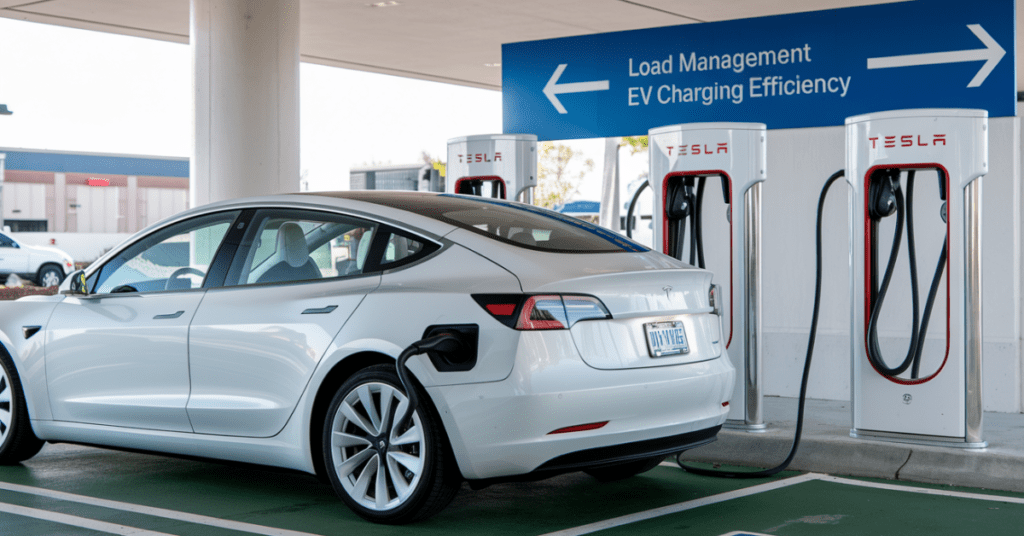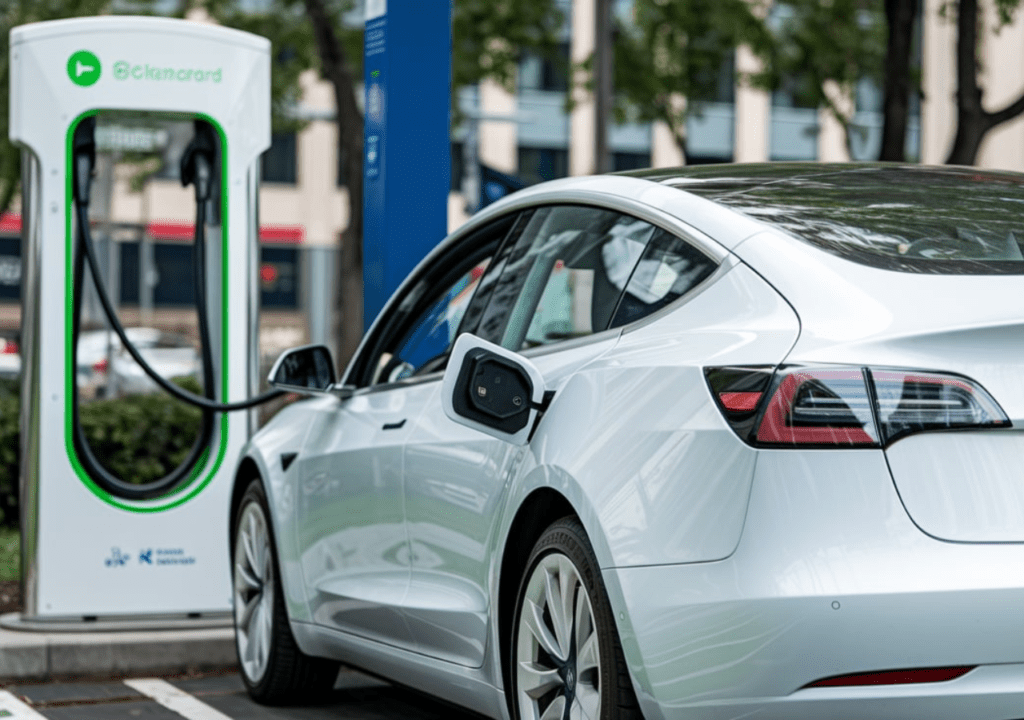Load management is a strategic method of balancing the supply and demand of energy to maintain a power system’s stability, efficacy, and dependability. Minimize grid overloads, blackouts, or wasteful energy usage, entails regulating patterns of energy use, especially during times of peak demand. This may be performed in several ways, including integrating renewable energy sources, using devices to store electricity, and moving non-required power consumption to off-peak hours. This concerted effort involves homes, companies, and utilities.
Load management helps to save money and protect the environment in addition to preserving grid stability. Energy companies can minimize the need for costly and environmentally harmful backup power facilities by lowering peak demand. Additionally, it encourages a resilient and sustainable energy environment by providing customers with tools like automated meters and incentives for optimizing their consumption of energy.
Load Management Enhance EV Charging Efficiency
- Prevents Grid Overload: Load management balances energy demand during peak times by adjusting charging schedules. This avoids grid strain and ensures a stable power supply, even as EV adoption grows. It keeps the power flowing properly throughout the system by judiciously allocating energy.
- Optimizes Charging Times: When power demand and tariffs are lower during off-peak hours, computers plan EV charging. In addition to saving consumers money, this additionally eases the strain on the grid during times of heavy demand, improving the efficiency of the charging process as a whole.
- Encourages Renewable Energy Use: charging for electric vehicles incorporates renewable energy sources such as wind and solar power through load control. It encourages better energy use and lessens dependency on fossil fuels by coordinating charging schedules with the availability of renewable energy.
- Improves Charging Speeds: By dynamically balancing the load across multiple EVs and stations, load management ensures consistent and optimal charging speeds. This minimizes delays and enhances user convenience, especially in public and commercial charging setups.
- Reduces Energy Wastage: Intelligent energy distribution ensures that electricity is used efficiently during charging. By preventing overuse or underuse of power, load management minimizes energy wastage, contributing to both cost savings and environmental sustainability.
- Increases Infrastructure Capacity: Load management maximizes the potential of existing charging infrastructure. By efficiently distributing energy, it reduces the need for costly upgrades while supporting the growing demand for EV charging stations.
Benefits of Load Management for EV Charging
- Prevents Grid Overload: By controlling when and how much power is used for EV charging, load management reduces the risk of overloading the power grid during peak hours.
- Cost Savings: Optimizing charging times, such as during off-peak hours, helps reduce electricity costs for both EV owners and utility providers.
- Supports Renewable Energy: Load management allows EVs to charge when renewable energy sources, like solar or wind, are plentiful, promoting cleaner energy use.
- Improves Charging Efficiency: By balancing the energy demand across multiple vehicles and stations, load management ensures faster and more efficient charging without overburdening the system.
- Reduces Carbon Footprint: Smart charging solutions help minimize the environmental impact by using cleaner energy and avoiding unnecessary power consumption.
- Increases Infrastructure Capacity: Load management helps make the most of existing charging stations, preventing the need for expensive infrastructure upgrades while supporting more EVs on the road.
Why Should EV Charging Providers Care About EV Charging Load Balancing?
- Preventing Overload and Downtime: Load balancing ensures that charging stations do not exceed their power limits, preventing outages or equipment damage. This maintains continuous service and reduces operational disruptions, ensuring reliability for users.
- Optimizing Energy Costs: Load balancing allows charging providers to control when and how much electricity is used, enabling them to reduce peak demand charges and benefit from lower off-peak rates, leading to significant cost savings.
- Enhancing Customer Experience: By evenly distributing the load, EV owners can experience faster, more reliable charging. It minimizes wait times and ensures that all users have access to available charging stations, improving overall customer satisfaction.
- Supporting Grid Stability: Load balancing helps manage energy distribution without overburdening the grid. Providers who implement load management strategies help maintain a stable grid, particularly as the number of electric vehicles on the road continues to rise.
- Future-Proofing Infrastructure: As EV adoption grows, charging providers must prepare for higher demand. Load balancing ensures that existing infrastructure can support future growth without needing costly upgrades, making it a sustainable solution for expanding charging networks.
- Boosting Sustainability Efforts: By coordinating charging with renewable energy availability and reducing energy wastage, load balancing contributes to a greener, more sustainable charging network, which is increasingly important to both consumers and regulatory bodies.
How CITA EV Chargers Solve EV Charging Load Management?
CITA EV chargers offer a smart solution for EV charging load management by integrating advanced technologies that optimize energy distribution. These chargers utilize dynamic load balancing, which ensures that the available power is distributed evenly across multiple charging stations, preventing grid overloads. By automatically adjusting the charging speed based on real-time demand, CITA chargers help reduce strain on the local electrical infrastructure.
Furthermore, CITA’s smart charging system allows for scheduled charging based on off-peak hours or the availability of renewable energy sources like solar or wind. This enables users to charge their EVs when energy prices are lower, reducing costs while also supporting a greener energy grid.
Additionally, CITA chargers are equipped with vehicle-to-grid (V2G) integration, which allows EVs to not only draw power but also supply it back to the grid when necessary. This functionality enhances grid stability, especially during peak demand periods, and encourages more sustainable energy use.
Technological Innovations in EV Load Management
1. Role of Smart Grids and IoT
Smart grids, equipped with sensors and IoT devices, enable real-time communication between EV chargers, grid operators, and energy sources. This connectivity allows for dynamic load adjustments, ensuring optimal power distribution. IoT-enabled chargers can collect and transmit data, helping monitor energy consumption patterns and improve overall grid performance while supporting renewable energy integration.
2. AI-Powered Optimization of Loads
To understand the huge amounts of data from EV chargers, grids, and weather patterns, artificial intelligence (AI) is essential. AI systems balance loads in real-time, optimize charging schedules, and forecast energy use. To save expenses and maintain grid stability, these systems may provide priority to charging during off-peak hours or when renewable energy is abundant.
3. Developments in Battery Storage
Modern battery storage systems work alongside load management solutions to store surplus energy during low-demand periods and release it during peaks. This helps maintain a steady energy flow, even when the grid is under stress. Advanced batteries with improved efficiency and capacity allow for more reliable energy buffering, supporting uninterrupted EV charging services.
4. Grid Interaction Innovations
Vehicle-to-grid (V2G) technology enables EVs to return unused energy to the grid, acting as mobile energy storage units. This bidirectional interaction helps stabilize the grid during peak demand. Combined with load management systems, V2G ensures energy is distributed efficiently while allowing EV owners to earn incentives for sharing stored energy.
Future Trends in EV Load Management
1. AI and Predictive Analytics in Charging
Overview: AI and machine learning transform EV load management by predicting optimal charging times and power levels based on user behavior and grid conditions.
Impact: By allowing smarter, more effective charging, this lowers expenses and grid stress while assisting in balancing demand with available energy availability.
Applications: In both home and business settings, real-time data gathering and analysis can calculate charging demands, optimize energy consumption, and identify the ideal charging time.
Overview of Vehicle-to-Grid (V2G) Integration: V2G technology transforms electric vehicles into mobile energy storage devices by enabling them to return energy to the grid when necessary.
Impact: By storing extra energy produced from solar or wind power, it encourages the integration of renewable energy sources and aids in systems stability when times of increased demand.
Applications: V2G may increase the resilience of energy networks and enable EV owners to take advantage of energy trading by supplying dependable electricity for residences, commercial buildings, or the grid.
Extending Connections for Charging
Overview: To ensure that charging stations are easily accessible as EV use increases, it is imperative to extend the charging infrastructure.
Impact: By enhancing convenience, lowering range anxiety, and enticing more people to convert to electric vehicles, expanding charging networks will aid in the shift to sustainable energy.
Applications: Investment in fast-charging stations, especially in urban and rural areas, and the development of charging solutions for commercial fleets will be key to ensuring a robust network.
Conclusion
Because load management maximizes charging efficiency and lessens grid stress, it is essential to the broad adoption of electric vehicles (EVs). It enhances the entire infrastructure for charging, reduces energy costs, and helps balance demand. Managing load will be crucial as more people choose electric cars to maintain a steady power supply without placing undue burden on the system. It will be simpler to create a sustainable and efficient charging environment thanks to significant developments like AI-driven charging, vehicle-to-grid (V2G) integration, and growing imposing networks. We must keep funding the infrastructure, technology, and laws that enable sophisticated EV charging management if we hope to create a future-proof system. The transition to more affordable, accessible, and ecologically benign electric vehicles will be facilitated by these measures.
FAQs
How does load affect EV range?
Load affects EV range by consuming more energy when additional accessories or heavy cargo are used, reducing overall driving distance.
How can I make my EV battery more efficient?
To make your EV battery more efficient, avoid rapid charging, drive smoothly, maintain optimal tire pressure, and minimize excess weight.
How can I increase battery efficiency?
To increase battery efficiency, charge within the recommended range, avoid extreme temperatures, reduce rapid acceleration, and keep your battery well-maintained.



